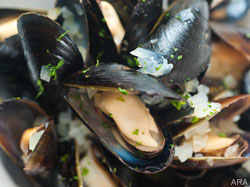
(ARA) – Sustainability is a term we’re hearing more often in today’s environmentally conscious world. Increasingly, Americans are examining what they eat, where it comes from and how the environment is affected by the foods they choose.
When it comes to seafood, farmed blue mussels are one of the greenest choices around. In fact, Monterey Bay Aquarium’s Seafood Watch Program lists farmed mussels as a “super green” seafood product. Seafood Watch bases its selections on a variety of factors, including the fishery, habitat, species, management and other factors that affect each species, as well as their Omega 3 content.
“Nearly 75 percent of the world’s fisheries are fished to capacity, or overfished, but our seafood choices have the power to improve that situation,” says Linda Duncan, executive director of the Mussel Industry Council of North America. “Blue mussels are grown naturally, in their own environment. They’re harvested by hand in Atlantic Canada and shipped fresh to your local restaurants and grocery stores.”
And mussels grow in abundance. Each female releases as many as 20 million eggs in the spring, which float in the ocean waves, get fertilized and then latch onto mussel farmers’ collector ropes, where they continue to grow to maturity as they naturally would.
Rope farming also helps improve the ocean environment by creating a man-made reef to improve biodiversity below. Because mussels grow naturally, fuelled by nutrients found in the ocean, they will be available for many years to come.
“Consumers can feel good about choosing farmed, rope-cultured blue mussels because they’re choosing a food that is fresh, healthy and grows in abundance,” says Duncan. “Not only that, but mussels are grown and harvested in an extremely sustainable manner.”
Mussel farming also happens to be a sustainable industry on land. Mussel farmers in rural communities have been growing and harvesting the shellfish for generations. Their families depend on this type of farming, and the jobs associated with processing mussels.
“When you see fresh blue mussels in the supermarket, or order them at a restaurant, you’re supporting the individual farmers who work out on our northern waters all year round to harvest these shellfish. It’s a very traditional industry, one which depends on and supports environmental sustainability,” Duncan explains.
Mussels are a ‘super green’ food that offer tremendous health benefits. In addition to being low-fat, they’re an excellent source of protein, Omega 3s, iron, zinc, Vitamin C and B12.
Preparing blue mussels is easy and quick. Rinse them and add to a pot with 1/4 cup of liquid. Cover and steam for five to seven minutes. They can be spiced up for more elegant occasions, or served plain with butter and crusty bread for a weekday meal.
Here’s an example of a simple way to prepare mussels. You can find more information about cultivated blue mussels and other recipes at www.discovermussels.com.
Herbed Steamed Mussels
Number of servings: 4
Preparation time: 5 minutes
Ingredients
• 2 pounds fresh cultured blue mussels, in shell
• 1 teaspoon thyme
• 1 tablespoon parsley, chopped
• 1 lemon, thinly sliced
Instructions
1. Rinse fresh blue mussels in tap water.
2. Place in large pot, cover and steam until the shells open (5-7 minutes).
3. Drain broth into a saucepan, add thyme and parsley, cover and simmer for 10 minutes. Place fresh blue mussels and lemon slices in a bowl and pour in the broth mixture.





